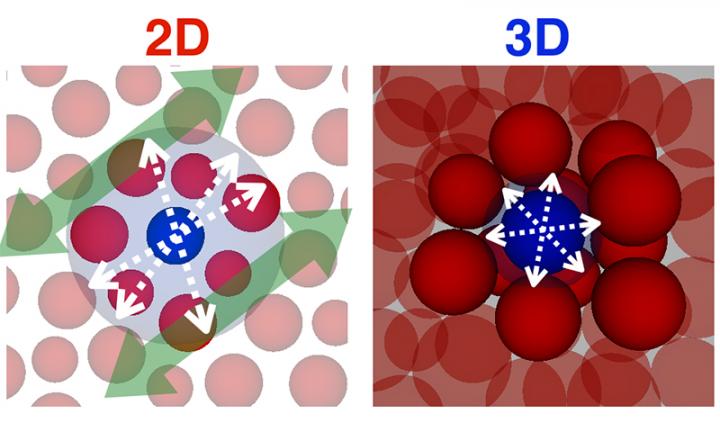Supercomputer simulation reveals 2-D glass can go infinitely soft

Left and right figures are schematic diagrams of glassy solid in two and three dimensions. Modality of the dynamics of glassy solid in different dimensions is illustrated. In three dimensions, a particle vibrates inside a cage formed by neighboring particles, due to the densely packed condition of the particles, and intermittently goes out of the cage. In two dimensions, long-wavelength vibrational sound waves induce coherent motion of the particles with a large amplitude that can in principle exceed the length scale of particle radii (the aqua colored circle on the left indicates that the caged particle can move a large distance). Credit: Hayato Shiba
“Imagine if we could make a sheet of glass, which has a two-dimensional (2D) planate shape,” says Dr. Hayato Shiba, of Tohoku University's Institute for Materials Research (IMR). “In such a confined spatial dimension, a variety of novel phenomena takes place in usual “periodic” systems (crystals, spin systems etc.). This is due to the thermal motion of the constituents taking place on a larger scale because of the limited spatial dimensions.”
Such enhanced thermal motion is known to induce new physical phenomena which Shiba, and his research team of Yasunori Yamada (IMR), Takeshi Kawasaki (Nagoya University) and Kang Kim (Osaka University), hope will lead the development of new functional materials and devices necessary for the realization of energy-saving societies.
However, it is still uncertain whether 2D glass, as an “non-periodic” system, exhibits such enhanced thermal motions.
“Our result indicates that 2D glass can become soft, gradually and forever, as we go to the macroscopic scales. Consequently, the vibration amplitude becomes infinite because of the large-scale motions,” says Shiba.
“In other words, such materials might exhibit strong responses to external fields or deformation. The thermal vibration is perfectly different from that in a 3D glass, and it can even alter the fundamental nature of vitrification and glassy phase transition.”
In the experiments, 2D glass was experimentally realized using colloidal systems, and can also be realized using other soft and hard materials.
Media Contact
All latest news from the category: Materials Sciences
Materials management deals with the research, development, manufacturing and processing of raw and industrial materials. Key aspects here are biological and medical issues, which play an increasingly important role in this field.
innovations-report offers in-depth articles related to the development and application of materials and the structure and properties of new materials.
Newest articles

Silicon Carbide Innovation Alliance to drive industrial-scale semiconductor work
Known for its ability to withstand extreme environments and high voltages, silicon carbide (SiC) is a semiconducting material made up of silicon and carbon atoms arranged into crystals that is…

New SPECT/CT technique shows impressive biomarker identification
…offers increased access for prostate cancer patients. A novel SPECT/CT acquisition method can accurately detect radiopharmaceutical biodistribution in a convenient manner for prostate cancer patients, opening the door for more…

How 3D printers can give robots a soft touch
Soft skin coverings and touch sensors have emerged as a promising feature for robots that are both safer and more intuitive for human interaction, but they are expensive and difficult…





















